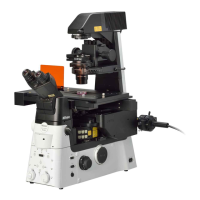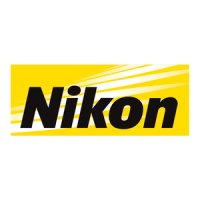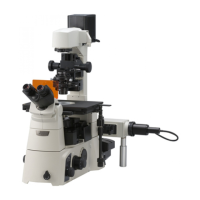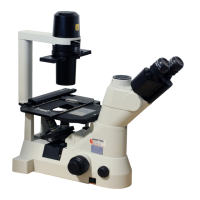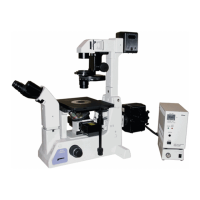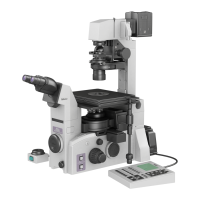Chapter 4 Microscopy Techniques
94
4.4 Details of Episcopic Fluorescence (Epi-FL) Microscopy
4.4.1 Principles of Epi-FL Microscopy
Epi-FL microscopy is a technique of observing
specimens labeled with a fluorophore or fluorescent
protein using episcopic illumination.
Fluorescent material absorbs light of specific
wavelengths (excitation light), and emits light of
specific wavelengths (fluorescent light) when it
decays from the excited state to the original state
(ground state.).
Visualizing fluorescent material
Because the brightness of fluorescent light is very
weak when compared with excitation light, excitation
light needs to be removed in order to observe only
the portions with fluorescent labeling. Therefore,
excitation light is removed from the observation
optical path using a filter cube (utilizing a
characteristic of the fluorescence that has a longer
wavelength than excitation light.).
The filter cube is composed of an excitation filter, a
dichroic mirror, and a barrier filter. The excitation
filter restricts the transmissive wavelength range of
excitation light. The dichroic mirror reflects
short-wavelength excitation light to irradiate the
specimen, and then allows long-wavelength
fluorescent light (emitted from fluorescent material)
to pass through the dichroic mirror. The barrier filter
restricts the transmissive wavelength range of
fluorescent light, and removes leaked excitation light
and autofluorescence. The wavelength characteris-
tics of optical elements of a filter cube are shown in
the following figure.
100
80
60
40
20
0
400 450 500 550 600 650 700
Wavelength (nm)
Wavelength characteristics of fluorescent materials
and the excitation filter, the dichroic mirror, and the
barrier filter
Epi-FL microscopy optical system
The Epi-FL microscopy optical system is shown in
the following figure.
Optical path diagram of Epi-FL microscopy
Excitation light emitted from the light source enters
the filter cube from the rear of the microscope, and
the excitation light of a specific wavelength is
transmitted by the excitation filter. The excitation light
is reflected upward by the dichroic mirror and
concentrated onto the rear-side focal plane of the
objective. The excitation light is irradiated intensively
to the field of view, and fluorescent materials in the
specimen in the field of view emit fluorescence. The
fluorescent light passes through the objective and
enters the filter cube from above, and then it passes
through the dichroic mirror and the barrier filter to
form a fluorescent image.
Noise terminator
Noise terminator—a unique optical system in NIKON
fluorescent microscopes—provides high-contrast
fluorescent images by practically eliminating
excitation light (not reflected by the dichroic mirror)
from the observation optical system.
Transmittance (%)
Excitation filte
(EX filter)
Barrier filter
(BA filter)
Dichroic
mirror
bsorption wavelength
range by FITC
Fluorescent wavelength
ran
e b
FITC
Specimen
Objective
2nd tube lens
Image plane
Excitation filte
Dichroic mirro
Barrier filte
Excitation light Fluorescen
Fluorescen
Noise
terminator
Part of excitation
light
Light source
side

